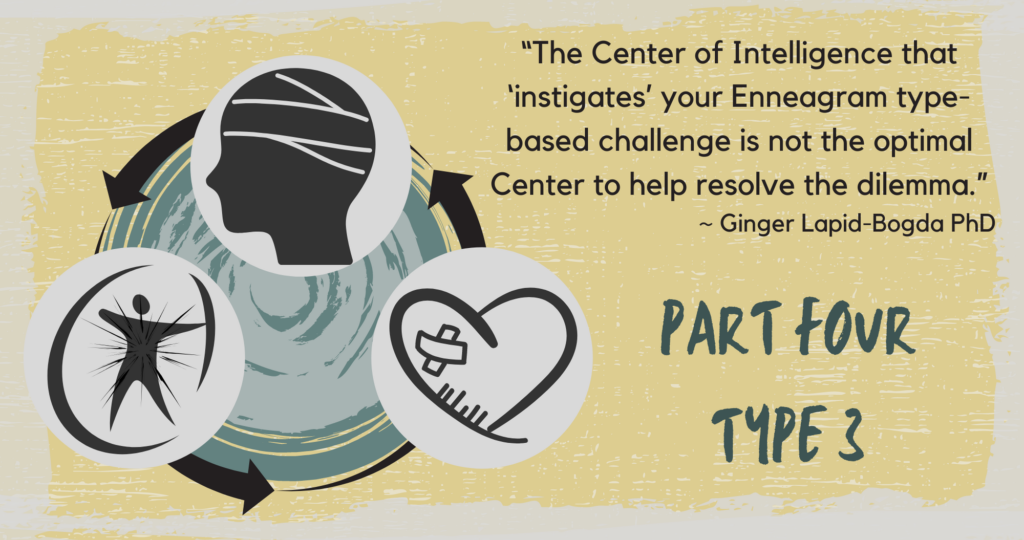 Although this statement may sound counter-intuitive, over years of working with people and groups on the Enneagram-based development, this has proven to be more accurate than not. Of course, working with the Center of Intelligence that instigates the challenging dynamic can be effective, it is simply more difficult. If the Head Center is the instigator, can the Head Center easily change course? To clear the Mental Center, soothe the Heart Center, or calm or embody the Body Center, another Center of Intelligence can be called into service to help support the desired growth and transformation.
Although this statement may sound counter-intuitive, over years of working with people and groups on the Enneagram-based development, this has proven to be more accurate than not. Of course, working with the Center of Intelligence that instigates the challenging dynamic can be effective, it is simply more difficult. If the Head Center is the instigator, can the Head Center easily change course? To clear the Mental Center, soothe the Heart Center, or calm or embody the Body Center, another Center of Intelligence can be called into service to help support the desired growth and transformation.
This 9-nine-part blog series will clarify this developmental idea for each of the 9 Enneagram types, with this blog focusing on Enneagram type Three.
A common type Three development area
Believing I’m only as good (valuable) as my last performance (accomplishment)
Because Threes believe this idea so deeply and so pervasively, it impacts almost everything they do on a daily basis. With the constant need to demonstrate their worth or value, Threes experience a continuous pressure to display their competence in being able to get things done and done well. This belief and behavior response seems to Threes as if it is in their DNA, thus making it so challenging to stop the pattern. This also becomes exhausting, as it requires Threes to constantly and continuously prove themselves time and time again. In addition, the Three’s self-worth is interwoven with both their performance and the audience reaction – that is, what they perceive the reactions of others either is or might be. In other words, there is always a visible or invisible audience in almost everything the Three does. As a result, the pressure to perform can be daunting, but, then again, Threes are used to this way of functioning.
The ‘instigator’ of this pattern or dynamic in Three is the Head Center in the sense that the Three’s mind creates an image (or gets a sense) of what an effective performance would be like and Threes then use their mental planning function to create scenarios and plans for how to accomplish their mission. A case could be made that this pattern starts in the Heart Center with Threes feeling anxious or uncomfortable with their self-worth or value, but the main ‘instigator’ then shifts quickly to the Head Center.
All this leads to the Center that is best suited to guide Threes into awareness of and the ability to relax the mental lockdown that occurs in Three when they so continuously think about and feel the need to perform: the Body Center. Although Threes often use the Body Center for doing something on behalf of their performance needs, the Body Center can also be used for non-doing, which is not doing nothing. Non-doing is more akin to being in a state of ‘being’ rather than a state of ‘doing.’ ‘Being,’ at first, may sound foreign to Threes, and many Threes try to figure out mentally what ‘being’ is and then they try to do ‘being.’ However, it is not possible to do ‘being.’
Here’s a simple and direct way to access the Body Center as an offset to Believing I’m only as good (valuable) as my last performance (accomplishment). Allow yourself to go into nature, someplace that has visual appeal, as well as smells so you can tune into your olfactory senses and sounds that may be subtle – for example, the wind – or more distinctive, such as birds singing or chirping or waves splashing. In other words, invite your senses to be your guide and simply experience yourself in your body in a natural space with nothing to do but to simply be there. Engaging in the above regularly – daily, weekly – allows you to be more fully in your Body Center as long as you don’t try to ‘do’ being in nature. So don’t use the phone, emails, or text messaging while you are there. No to ’do!’ Yes to ‘be!’
Ginger Lapid-Bogda PhD, author of eight Enneagram books, is a speaker, consultant, trainer, and coach. She provides certification programs and training tools for business professionals around the world who want to bring the Enneagram into organizations with high-impact business applications. TheEnneagramInBusiness.com | ginger@theenneagraminbusiness.com

Comments are closed.